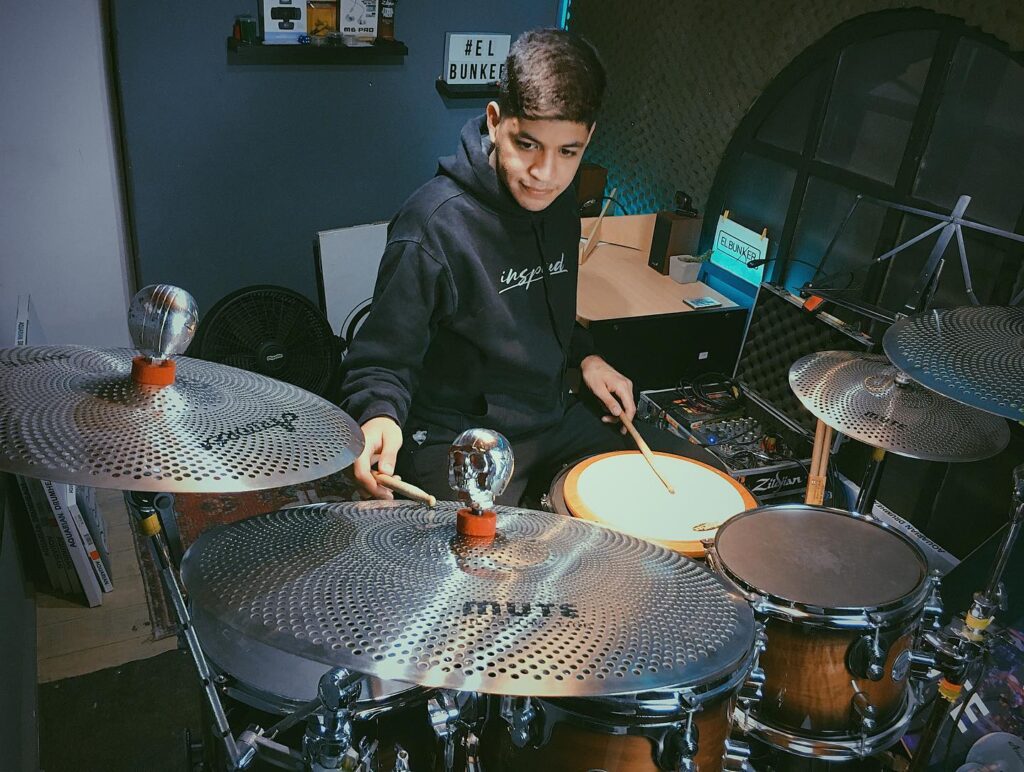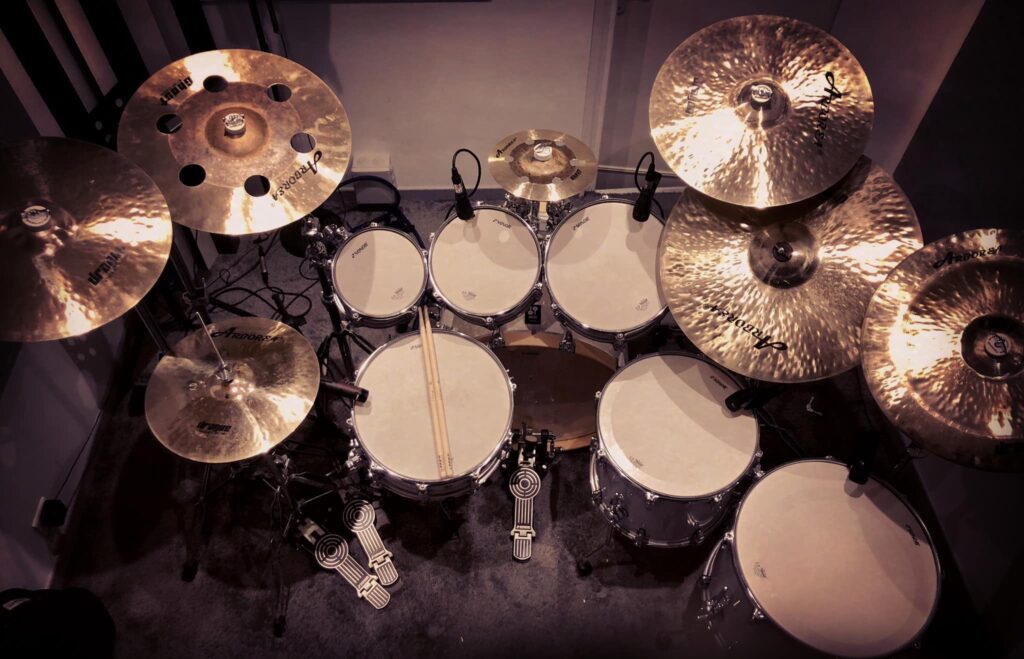The ride cymbal’s journey begins in the early 20th century, where it was primarily used in jazz music. The term “ride” refers to the technique of playing a steady pattern on the cymbal, which “rides” over the music, providing a continuous rhythmic backdrop. This technique was pioneered by jazz drummers like Baby Dodds, who revolutionized ride cymbal playing with his smooth, flowing style. The evolution of the ride cymbal pattern from 1917 to 1941 highlights its growing importance in jazz, as it transitioned from simple time-keeping to a more expressive component of the drum kit. The development of the ride cymbal was significantly influenced by the innovations of cymbal manufacturers. For instance, the flat ride cymbal, which lacks a bell, was developed by Paiste in collaboration with jazz drummer Joe Morello in the 1960s, offering a drier, more controlled sound9. This type of cymbal became popular among jazz musicians for its ability to blend smoothly into the ensemble without overpowering other instruments.

Cymbals serve as an integral component of a drum set, adding texture, dynamics, and accents to the overall sound. They provide the drummer with a wide range of tonal possibilities and help create a musical atmosphere. Among the various cymbals used in a drum set, the ride cymbal plays a crucial role in establishing the rhythmic foundation.
The ride cymbal is a large, suspended cymbal that produces a clear and sustained sound. It is typically located on the right side of a drum set, positioned close to the drummer’s dominant hand. The ride cymbal is struck with a drumstick or mallet to produce rich and shimmering tones. It acts as a melodic and rhythmic centerpiece, providing a steady and continuous sound that holds the groove together.
A ride cymbal consists of several essential parts, each contributing to its unique sound and playability. The main components of a ride cymbal include:
Ride cymbals come in various types, each offering unique tonal characteristics and musical applications. Some common types of ride cymbals include:

Playing the ride cymbal involves various techniques that can significantly affect the sound and feel of the music. Some common techniques include:
Notable players like Tony Williams and Roy Haynes have been known for their innovative use of the ride cymbal, pushing the boundaries of what can be achieved with this instrument.
Ride cymbals have evolved over time, adapting to changing musical styles and drumming techniques. From the traditional ride cymbals of the past to the modern, specialized models available today, ride cymbals continue to undergo innovation and refinement.
In jazz, the ride cymbal is central to the drum set, often carrying the main rhythmic pattern. Techniques like the classic jazz ride pattern (ding-DA-ding-ding) help maintain the swing feel, essential for authentic jazz drumming.
In rock drumming, the ride often alternates with the hi-hat as the primary timekeeper. Using the ride cymbal to play steady eighth or sixteenth notes can add brightness and drive to the rock groove, especially in louder or more intense sections.
Funky rhythms on the ride cymbal often involve syncopation and off-beat accents. Techniques like hitting the bell on the “and” of each beat can create a distinctive funky feel, adding a crisp, percussive element to the groove.
Developing independence between the ride cymbal and other drum kit components is crucial. Practicing patterns where the ride cymbal maintains a steady rhythm while the other limbs play contrasting rhythms can enhance coordination and rhythmic accuracy.
Orchestrating the ride cymbal within the context of a full drum kit involves using it in ways that complement the other drums and cymbals. This might include transitioning between the ride and other cymbals for different sections of a song, or using the ride cymbal to accentuate specific musical phrases.
In blues, the ride cymbal often plays a swinging pattern that complements the laid-back feel of the music. Techniques like slight variations in the swing pattern or dynamic changes can help in expressing the soulful nuances of blues music.
Fusion drumming, which blends elements of jazz, rock, and other styles, often uses the ride cymbal to maintain a complex rhythmic framework. Advanced patterns and dynamic changes are common, requiring precise technique and control.
In Latin music, particularly salsa, the ride cymbal can be used to add a high-pitched, rhythmic layer over the congas and other percussion instruments. Patterns often include rapid bell hits and syncopated bow strikes that mirror the energetic feel of Latin rhythms.
In metal, the ride cymbal often cuts through the dense texture of distorted guitars and fast-paced rhythms. Playing the bell for a piercing, continuous sound or using the bow for fast, driving patterns helps maintain the intensity typical of metal music.
Country music often utilizes the ride cymbal for a steady, driving rhythm that supports the typically lyrical and vocal-centric arrangements. Simple, consistent patterns on the ride help maintain the straightforward, rhythmic feel of country music.
In world music, the ride cymbal’s versatility is tapped to blend with a variety of percussion instruments. Techniques might include using the ride for steady rhythmic patterns or for accentuating specific beats in a complex rhythmic cycle.
Even in electronic music, where digital sounds predominate, the acoustic ride cymbal can add an organic touch. Techniques might involve processing the ride cymbal sounds with effects to blend seamlessly with electronic beats.
Reggae drumming uses the ride cymbal to provide a smooth, flowing rhythmic feel. Often played with a lighter touch, the ride in reggae complements the relaxed tempo and syncopated bass lines typical of the genre.
In hip-hop, the ride cymbal can add a crisp, live-played feel to the predominantly sample-based beats. It’s often used sparingly to accentuate certain parts of the beat or to provide a contrast to the heavier snare and bass sounds.
Experimental drumming often involves using the ride cymbal in unconventional ways, such as bowing the edge with a cello bow or applying chains and beads to create unique sound textures.
In drum solos, the ride cymbal often takes center stage, allowing the drummer to display their technical skill and creativity. Solos might feature rapid bell patterns, dynamic bow rolls, and dramatic crashes to captivate the audience.
Ride cymbals play a significant role in shaping the sound and feel of different music genres. Here are some examples of how ride cymbals contribute to various genres:
The ride cymbal is a crucial component of a drummer’s arsenal, offering a versatile range of sounds and textures. Its sustained and melodic qualities make it an integral part of various music genres. Whether you’re playing jazz, rock, funk, or any other style, the ride cymbal adds depth, character, and groove to your drumming.
Remember to choose a ride cymbal that suits your musical preferences and playing style. Take good care of your cymbal to ensure its longevity and optimal performance. And most importantly, have fun exploring the vast possibilities and creative potential of the ride cymbal.
We will contact you within 1 working day, please pay attention to the email